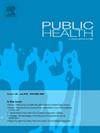Antibiotic prescribing patterns in the community and primary care settings through a gender lens: A systematic review
IF 3.9
3区 医学
Q1 PUBLIC, ENVIRONMENTAL & OCCUPATIONAL HEALTH
引用次数: 0
Abstract
Objectives
Gender differences affect exposure to infections, including drug-resistant ones. However, data on the relationship between gender and antibiotic use are limited. This systematic review examines gender differences in antibiotic prescribing patterns in community and primary care settings.
Study design
Systematic review.
Methods
We searched Web of Science (Core Collection), PubMed, Scopus, Cochrane Database, and EMBASE for studies published between January 2014 and April 2024. We included studies of any design that analyzed antibiotic prescribing patterns for patients consulting general practitioners. We excluded studies that did not examine gender differences, unpublished reports, and non-English articles. We conducted a narrative synthesis of the findings. The review is registered in PROSPERO (CRD42023476119).
Results
Our search identified 12,853 citations, from which we included 11 studies conducted in 10 countries. Most studies (n = 7) were cross-sectional. Gender analysis of antibiotic prescribing in the included studies did not show a consistent pattern in the likelihood of antibiotic prescription based on gender. The most commonly prescribed antibiotics were azithromycin, amoxicillin, cephalexins, penicillin, clarithromycin, and metronidazole, primarily for respiratory infections, sinusitis, bronchitis, pneumonia, COVID-19, skin, and musculoskeletal diseases. Most studies did not report dose compliance.
Conclusions
Our systematic review identifies gender as a factor in antibiotic prescribing that remains insufficiently explored. Further research and policy discussions are needed to examine global prescribing patterns through a gender lens.
从性别视角看社区和初级保健机构的抗生素处方模式:一项系统综述
目的性别差异影响感染暴露,包括耐药感染。然而,关于性别与抗生素使用之间关系的数据有限。本系统综述探讨了社区和初级保健机构抗生素处方模式的性别差异。研究设计:系统评价。方法检索Web of Science (Core Collection)、PubMed、Scopus、Cochrane Database和EMBASE,检索2014年1月至2024年4月间发表的研究。我们纳入了所有设计的研究,这些研究分析了咨询全科医生的患者的抗生素处方模式。我们排除了没有检查性别差异的研究、未发表的报告和非英语文章。我们对调查结果进行了叙述综合。该审查已在PROSPERO注册(CRD42023476119)。结果:我们检索了12,853次引用,其中包括在10个国家进行的11项研究。大多数研究(n = 7)是横断面研究。在纳入的研究中,对抗生素处方的性别分析没有显示出基于性别的抗生素处方可能性的一致模式。最常用的抗生素是阿奇霉素、阿莫西林、头孢氨苄、青霉素、克拉霉素和甲硝唑,主要用于呼吸道感染、鼻窦炎、支气管炎、肺炎、COVID-19、皮肤和肌肉骨骼疾病。大多数研究没有报告剂量依从性。结论我们的系统评价认为性别是影响抗生素处方的一个因素,但尚未得到充分的探讨。需要进一步的研究和政策讨论,以通过性别视角审查全球处方模式。
本文章由计算机程序翻译,如有差异,请以英文原文为准。
求助全文
约1分钟内获得全文
求助全文
来源期刊

Public Health
医学-公共卫生、环境卫生与职业卫生
CiteScore
7.60
自引率
0.00%
发文量
280
审稿时长
37 days
期刊介绍:
Public Health is an international, multidisciplinary peer-reviewed journal. It publishes original papers, reviews and short reports on all aspects of the science, philosophy, and practice of public health.
 求助内容:
求助内容: 应助结果提醒方式:
应助结果提醒方式:


